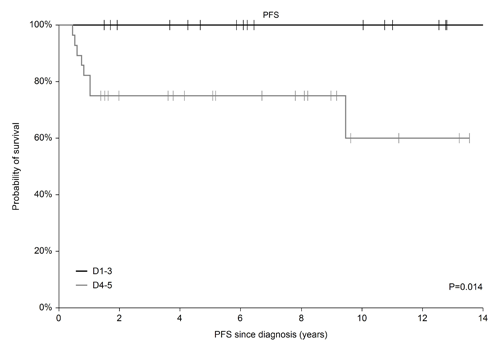
Contributions
Abstract: EP552
Type: E-Poster Presentation
Session title: Aggressive Non-Hodgkin lymphoma - Clinical
Background
Primary mediastinal large B-cell lymphoma (PMBCL) is a specific clinicopathological and molecular subtype of non-Hodgkin lymphoma characterized by rapid progression of anterior mediastinal mass, commonly affecting younger patients. Standard therapeutic approach to PMBCL is immunochemotherapy with antracyclines followed by mediastinal radiation. PMBCL is nowadays considered to have better outcome than DLBCL, with PFS approximately 80% and OS 90%, respectively. Considering new therapy options (immune checkpoint inhibitors) seems to be important to identify chemorefractory patients with early relapse regarding early indication of novel drugs. As a powerful tool for response assessment is positron emission tomography with fluorodeoxyglucose (FDG). Even though this method is commonly used, the prognostic value of interim PET/CT is considered to be unclear and controversial.
Aims
To assess a predictive value of interim PET/CT as potentially useful tool for early recognition and further management of chemorefractory PMBCL.
Methods
We conducted a retrospective study of patients diagnosed with PMBCL. Between 2005-2019 we identified 53 patients, interim FDG PET/CT has been performed in 45 of them. Imaging studies were conducted using the Siemens Biograph 16 HI-REZ (2008-2015) and Siemens mCT 40 (2015-2017) systems with the same image acquisition protocols at the same centre. Both PET/CT scanners were accredited by EARL, a European Association of Nuclear Medicine research initiative. Images were read by two independent experts blinded for patient outcome.
Results
This cohort consisted of 27 females and 18 males with median age of 33 years. All of the patients have been treated with immunochemotherapy regimen containing rituximab and antracyclines, 30 of them have undergone autologous stem cell transplant and 4 of them had radiotherapy. All but two patients had final PET/CT, according to this 33 (73.3%) of them achieved CR, six (13.3%) PR, four (8.8%) had progressive disease. Interim FDG PET/CT was considered positive in 27 (60%) from 45 patients using visual evaluation. Interim PET/CT was assessed as negative (Deauville 1-3) in 17 (37.8%) patients and positive (Deauville 4-5) in 28 (62.2%) patients, respectively. In the negative interim FDG-PET/CT group no patient has relapsed, in positive interim PET/CT group 8 patients relapsed with median time to progression 9 months. Five-year PFS reached 75% and 100% (p=0,014) and 5-y OS 78.2% and 100% in groups D4-5 vs D1-3. Positive and negative predictive values were 28.6% and 100% for PFS-event.

Conclusion
Interim FDG-PET/CT negativity is associated with high negative predictive value for lymphoma progression. We can consider negative interim FDG-PET/CT as single valued method in detection of early response in chemosensitive patients. Regarding positive predictive value, for better identification of chemorefractory disease and patients suspect of early progression further analyses are needed. Extensive studies to estabilish the role of the interim PET/CT should contain assessment of specific metric values available in PET/CT scan as SUV max (maximum standardized uptake volume), MTV (metabolic tumor volume), TLG (total lesion glycolysis) or metabolic heterogeneity.
Acknowledgement: supported by AZV NU21-03-00411 and IGA_LF_2021_001 grants
Keyword(s): PET, Prognosis
Abstract: EP552
Type: E-Poster Presentation
Session title: Aggressive Non-Hodgkin lymphoma - Clinical
Background
Primary mediastinal large B-cell lymphoma (PMBCL) is a specific clinicopathological and molecular subtype of non-Hodgkin lymphoma characterized by rapid progression of anterior mediastinal mass, commonly affecting younger patients. Standard therapeutic approach to PMBCL is immunochemotherapy with antracyclines followed by mediastinal radiation. PMBCL is nowadays considered to have better outcome than DLBCL, with PFS approximately 80% and OS 90%, respectively. Considering new therapy options (immune checkpoint inhibitors) seems to be important to identify chemorefractory patients with early relapse regarding early indication of novel drugs. As a powerful tool for response assessment is positron emission tomography with fluorodeoxyglucose (FDG). Even though this method is commonly used, the prognostic value of interim PET/CT is considered to be unclear and controversial.
Aims
To assess a predictive value of interim PET/CT as potentially useful tool for early recognition and further management of chemorefractory PMBCL.
Methods
We conducted a retrospective study of patients diagnosed with PMBCL. Between 2005-2019 we identified 53 patients, interim FDG PET/CT has been performed in 45 of them. Imaging studies were conducted using the Siemens Biograph 16 HI-REZ (2008-2015) and Siemens mCT 40 (2015-2017) systems with the same image acquisition protocols at the same centre. Both PET/CT scanners were accredited by EARL, a European Association of Nuclear Medicine research initiative. Images were read by two independent experts blinded for patient outcome.
Results
This cohort consisted of 27 females and 18 males with median age of 33 years. All of the patients have been treated with immunochemotherapy regimen containing rituximab and antracyclines, 30 of them have undergone autologous stem cell transplant and 4 of them had radiotherapy. All but two patients had final PET/CT, according to this 33 (73.3%) of them achieved CR, six (13.3%) PR, four (8.8%) had progressive disease. Interim FDG PET/CT was considered positive in 27 (60%) from 45 patients using visual evaluation. Interim PET/CT was assessed as negative (Deauville 1-3) in 17 (37.8%) patients and positive (Deauville 4-5) in 28 (62.2%) patients, respectively. In the negative interim FDG-PET/CT group no patient has relapsed, in positive interim PET/CT group 8 patients relapsed with median time to progression 9 months. Five-year PFS reached 75% and 100% (p=0,014) and 5-y OS 78.2% and 100% in groups D4-5 vs D1-3. Positive and negative predictive values were 28.6% and 100% for PFS-event.

Conclusion
Interim FDG-PET/CT negativity is associated with high negative predictive value for lymphoma progression. We can consider negative interim FDG-PET/CT as single valued method in detection of early response in chemosensitive patients. Regarding positive predictive value, for better identification of chemorefractory disease and patients suspect of early progression further analyses are needed. Extensive studies to estabilish the role of the interim PET/CT should contain assessment of specific metric values available in PET/CT scan as SUV max (maximum standardized uptake volume), MTV (metabolic tumor volume), TLG (total lesion glycolysis) or metabolic heterogeneity.
Acknowledgement: supported by AZV NU21-03-00411 and IGA_LF_2021_001 grants
Keyword(s): PET, Prognosis


